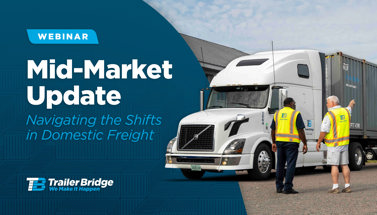
Pros and Cons of Intermodal Transport
Like all modes of transportation, you need to balance the pros and cons of intermodal shipping to decide if it is the right fit for your business. Below we walk you through a few pros and cons of this type of transport.
For more insights, including operational details, provider selection tips, benefits, and more, check out our Intermodal Transportation Guide.
Benefits
Cost Savings
One of the biggest incentives for shippers to use intermodal is the possibility for cost savings. When shipping distances of 500 miles or more, intermodal can be less expensive than OTR trucking traveling the same distance. In fact, shippers who switch from trucking to intermodal for long-distance shipments save an average of 10-40%.
The savings come from economies of scale. A train can carry a ton of freight more than 470 miles by rail, which is 4x more fuel efficient than a truck. The increased fuel efficiency makes for lower operational costs, which results in a lower cost per mile when traveling more than 500 miles. However, intermodal is not ideal for shipments traveling shorter distances because the cost of drayage would negate the cost per mile savings of rail.
Reliable Capacity
A single train can carry hundreds of containers and is rarely low on capacity, which makes intermodal a good option for volume shippers. Containers can even be double stacked on rail cars for shippers who need more space.
Intermodal’s ability to move large volumes of freight also makes it a good alternative for shippers who are short on truck capacity. This scenario may become even more common in the future, as trucking capacity is expected to become tighter with the growing shortage of truck drivers. In 2021, the American Trucking Association reported the industry had a shortage of 80,000 drivers and predicted that number will double by 2030.
Sustainability
With increased fuel efficiency, intermodal is a more environmentally sustainable mode of transportation. It also cuts down on the number of vehicles on the road, since a single train can carry the equivalent of 280 truckloads.
Disadvantages
Accessibility
Freight pickup and delivery locations must be within 100 miles of an intermodal ramp to maintain the cost savings benefit of shipping by rail, which limits the number of shippers who can take advantage of intermodal.
Most ramps are located near densely populated cities where the shipping demand is higher, leaving many rurally located shippers out of range. To view the closest intermodal facility near you, reference this map on the Intermodal Association of North America(IANA) website.
Limited Flexibility
If your shipment requires flexibility or is time-sensitive, then intermodal may not be the best form of transportation for you. Shipping routes are physically limited to areas where track is laid and the transportation timeline is determined by the railroad’s schedule instead of your business operations.
It’s also impossible to reroute a rail shipment once it’s in transit. This creates inconvenience and possible delay if a shipper’s delivery location changes or there is rail congestion.
Speed
Since intermodal involves moving freight between multiple modes of transportation, the complexity can result in longer transit times. There are multiple factors that may cause a delay during the process:
- Equipment Shortages: Truck chassis (for drayage) and containers are essential to intermodal. Sometimes, this equipment may not be readily available in periods of high demand. When this happens, shipments must be put on hold until these assets become available.
- Driver Availability: Drivers are needed to perform drayage to and from the rail facilities. If the drayage company is short on drivers, you may have to wait until one is available to move your load.
- Route Interchanges: Depending on the route your shipment is taking, it may run through an interchange. These areas, where the train is transferred from one track to another, require additional time to make sure the train remains in position while being redirected.
- Derailments: The catastrophic derailments shown on the news are not the norm. In fact, most derailments that occur are as small as a single wheel becoming misaligned with the track. These minor derailments are not a major cause of concern but still require that the train be delayed while it is repositioned correctly.
Weight Capacity
To remain in compliance with government weight regulations, Both dry vans and trucks carrying intermodal containers must not go over 80,0000 lbs. However, an intermodal container and chassis are about 2,500 lbs. heavier than a dry van attachment so it can carry less weight in freight overall.
When factoring in the weight of the tractor, this means that a dry van can carry about 45,000 lbs. of cargo while an intermodal container can carry no more than 43,500 lbs.
When to Use Intermodal
Here are some quick guidelines to follow when deciding if intermodal transportation is right for your freight:
- The shipment is traveling 500 miles or more: If your freight is moving more than 500 miles, using intermodal could cut down on your overall transportation costs.
- Your pickup and delivery locations are within 100 miles of an intermodal facility: If either location is more than 100 miles away, the drayage costs will negate savings from using rail transportation.
- You need consistent capacity to ship large volumes: Shippers of all sizes can benefit from intermodal. But If you are a high-volume shipper, it can be especially helpful due to the large capacity available. Trains can carry multiple truckloads worth of freight in one trip and rarely run out of space.
- The overall weight of the shipment is 43,500 lbs. or less: 43,500 lbs. is the most that your freight can weigh to meet government requirements after factoring in the weight of the other equipment.
- You have a flexible pickup and delivery window: Since intermodal shipping time can be unpredictable, a flexible schedule won’t put you at risk of missing a deadline in case of delay.
Domestic Intermodal vs. OTR Trucking
In the logistics world, OTR trucking and intermodal are often compared because they are the most common ways to transport freight domestically. While it’s true that they can both move freight over land for long distances, each has their strengths and weaknesses depending on your needs. This blog details how to weigh the pros and cons of each for your business.





